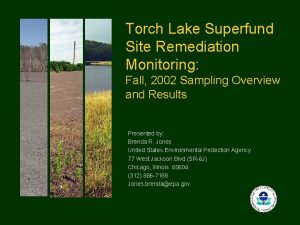Lead Contaminated Superfund Sites OPTIONAL LOGO HERE Sam

- Slides: 1

Lead Contaminated Superfund Sites OPTIONAL LOGO HERE Sam Johnson Loyola University Chicago Abstract The Superfund program was created in 1980 in response to the Love canal Disaster. The program was implemented during the Regan administration and was regulated and enforced by the Environmental Protection Agency. The main goals of the program were to identify contaminated sites, determine the responsible parties, and to finance the cost of cleanup when the responsible parties are unknown or unable. Most of the largest superfund sites areas where mining activity was previously high. The former presence of lead mines in particular pose a very significant threat to the environment, as the toxic nature of lead contamination has left a very detrimental impact in their wake. Since its formation, the superfund program has drawn much criticism regarding its effectiveness as a viable government program. The program’s reputation has been marred by ineffectiveness and problems in administration. Its critics view it as a largely bureaucratic process that consumes millions of dollars each year. Yet, the superfund program has been an essential concept in the damage control measures undertaken since the close of many prominent lead mines. Superfund Overview The Coeur d’Alene Superfund Site -Coeur d’Alene, Idaho is the former site of several major lead mines, as well as some currently active mines. It has been historically known for its abundance of lead and silver and has produced very large quantities of each since mining began in the late 1800’s. The major area of mining activity is known as the Bunker Hill region. - The topography of the region is characterized by many rivers, lakes, streams, and wetlands. Thousands of acres in the region have been contaminated with lead from the mining operations. This had a very detrimental impact upon the waterfowl that inhabit the region. An estimated 18, 000 acres contain lead levels that are toxic to waterfowl and other animals. -Coeur d’Alene poses one of the most significant challenges to superfund -In 1986, Lavelle resigned from her position and congress passed the Superfund cleanup. The vast size of the area and amount of hazardous material Amendments and Reauthorization Act, which increased the budget to $9 billion and allowed prevent traditional cleanup approaches, such as capping and removal, from for new technologies and studies to be implemented. being used. Parts of the community infrastructure are built on top and out of mining waste. The site Restoring encompasses. Bunker thousands. Hill of people across several -Superfund is provided broad federal authority in the clean up of existing or potential political jurisdictions and has proven to be a very complex, extensive, and hazardous releases. Currently, the number of listed superfund sites is 1, 240, with 317 sites expensive site to cleanup. In addition, the responsible parties are either recently de-listed and 61 proposed sites. unable or unwilling to pay for the remaining cleanup costs. -The cost of cleanup is usually deferred on to the company responsible for the pollution. Approximately seventy percent of the sites are paid for by the responsible party in regards to cleanup costs. If a party cannot pay the costs associated with cleanup or can not be found, the cost of cleanup is placed upon that of the government. Originally, the law provided funds for these costs by placing a tax on petroleum and hazardous chemicals with the intent of -One of the primary ways in which to prevent the further spread of encouraging the consumption of alternate goods instead. By the end of FY 1996, the balance of funds collected from these taxes was $6. 0 billion. By the end of FY 2003, this fund was contaminants throughout the Coeur d’Alene river is through ecological restoration. exhausted. Since then, funding for the orphan shares has been appropriated by Congress out of general revenues. -Recently, there has been a major project involving the revegetation of -Prominent former lead mining sites that are currently designated as superfund sites includethe soils. Revegetation involves using specially designed residuals such as biosolids and wood ash in order to promote the growth of Bunker Hill in Coeur d’Alene Idaho, Tar Creek in Oklahoma, the Galena Lead Mine in Galena, vegetative ground cover. Kansas, and the Lincoln Park/Cotter Mill site in Colorado. -Phytotoxicity was caused by high concentrations of trace metals, low p. H, low soil nutrients and organic matter, and poor soil physical properties. Wood ash contains much calcium carbonate, which can resolve soil acidity. Biosolids can limit metal toxicity and serve as a slow release nutrient source. They can also provide organic matter that improves soil tilth. The applications of these biosolids and wood ash can remedy these problems in the subsoil and support vegetative growth. -The results of this program were highly successful. The researchers were able to demonstrate that revegetation can occur reliably over the majority of the site area and the plants that were grown were very similar in metal content to that of plants grown in uncontaminated soil. Hell’s Half-Acre in Galena, Kansas. Dec. 2006 The Implementation of Adaptive Management -Adaptive management refers to a six-step process for defining and implementing environmental management actions in situations of high uncertainty regarding the outcome. The process consists of these six steps: -1) Assessing the Problem: This consists of determining the scope of the problem and defining measurable management objectives as well as potential management actions. Key uncertainties are also defined in regards to alternate management actions. -2) Designing a Management Plan: Different types of management actions are evaluated in terms of their potential effectiveness. A monitoring protocol is also developed to specify the types and quantities of baseline data. Indicator values that may specify a change in management actions/objectives are also defined. -3) Implementing the Plan: The management plan is implemented as specified. Any circumstance that requires that the plan deviate from its intended course must be identified and understood by all stakeholders. -4) Monitoring: Implementation monitoring must include three parts: monitoring for compliance, monitoring for effectiveness, and monitoring to validate the model parameters and relationships. -5) Evaluating results obtained from monitoring: A comparison between the evaluations drawn from monitoring are compared with those forecasted in step one. -6) Adjusting the Management Plan: Models involved in the initial References forecast should be updated and the objectives of management should possibly be reviewed and revised as necessary. -Barnthouse, L. W. , Brierly, C. L. , Clark, E. H. , & Ward, C. H. (2007). Superfund and Mining Megasites. Environmental Science & Technology (8) 41. 2667 -2672. -Moore, J. W. , Nguyen, K. T. , & Rotstein, P. H. (1997). Successful Soil Stabilization at a Lead Contaminated Superfund Site. Hazardous Industrial Wastes (29). 165 -173. -Rosen, J. F. (2003). A Critical Evaluation of Public Health Programs at the Bunker Hill Superfund Site. Science of the Total Environment (1 -2) 303. 15 -23. Two photographs taken from the Bunker Hill site during the revegetation project. www. Poster. Presentations. com Below is a map of current superfund sites in the United States. At present, there are 1, 240 sites listed on the Superfund National Priority List. - Due to the large amounts of mining, the area has given off much pollution that has seeped into the Coeur d’Alene river valley. An estimated 121 million tons of metals-enriched mine tailings were produced by the mines, with about 62 million tons going into the river basin’s streams. -In the 1970’s blood lead levels in children that lived in areas around the bunker hill site were elevated. Since the site has closed, blood lead levels - The superfund program was created by the government in response to what is known as the are now approaching that of same-age children in the general U. S. Love Canal incident, which consisted of the discovery of a large quantity of toxic waste population. beneath the Love Canal neighborhood in Niagra Falls, New York. It was created with the passage of the Comprehensive Environmental Response, Compensation, and Liability Act-The site was placed on the National Priority List in 1983. It initially (CERCLA). consisted of a 21 square mile “box” around the original smelting site. In 1998, the EPA began placing superfund requirements outside of the “box, ” -The program was initially headed by Rita Lavelle, a former employee of a company expanding the project site to 1500 square miles. The solution to the responsible for polluting the environment. Her administration imposed many industry favorable increased project area was an investment of $395 million over a thirty year policies that prevented significant action from taking place. period. TEMPLATE DESIGN © 2007 Sites within the United States -Sheldrake, S. , Stifelman, M. (2003). A Case Study of Lead Contamination Cleanup Effectiveness at Bunker Hill. Science of the Total Environment (1 -2) 303. 105 -123.

